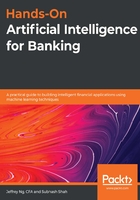
The basic concepts of financial banking
Before we move full steam aheadinto anotherexample,we will first craft out our data, AI, and business techniques and knowledge. If you are familiar with all of these concepts, feel free to skip this section.
Financial knowledge is a good place to start to understand how our decisions in forecasting business activities impact financial decision-making in non-financial firms. Additionally, when predicting future activities using a machine learning model, we also learn how the finance industry can prepare for this future volume of business. What financing does to help with core business activities in non-financial firms is covered in the following section.
The functions of financial markets – spot and future pricing
Financial markets, such as exchanges, play the role of markets for products to be exchanged. For example, consider commodities such as natural gas—we can either buy it directly from sellers or buy it via an exchange. As it turns out, long-running economics theories encourage you to buy the product from an exchange as much as possible if the product is standardized. Chicago Mercantile Exchange (CME) in the US could be a popular choice for commodities and, needless to say, the New York Stock Exchange (NYSE) is the market for publicly listed equities.
In this chapter, let's stick to natural gas as a product that we need. Of course, in some cases, it could be more efficient to buy it from big oil companies such as Shell—that is, if we want these physical goods from producers on a regular basis.
Within exchange markets, there are two prices— the spot price and the future price. Spot price means you can have goods (delivered) now if you pay; future price means you get the goods later by paying now.
Choosing between a physical delivery and cash settlement
Even if a change in ownership is to take place, it could occur in two forms, that is, via physical delivery or a cash settlement. Ultimately, physical delivery or a cash settlement depends on whether we need the goods immediately or not. However, on any given trading day, we must weigh up the cost of only two options: physical delivery (cost of natural gas + cost of financing + cost of storage) as opposed to a cash settlement.
Essentially, we have four options, as presented in the following table—assuming that we need to have the physical natural gas product in 3 months time for the generation of electricity:

To weigh up the options, we require the following data:
- Storage costs should be provided by the internal source if the company owns the storage facility for natural gas. It is assumed to be rather static, for example, at around 0.12 per MMBtu. MMBtu is a unit used to measure the energy content in fuel. It stands for one Million British Thermal Units.
- The financing cost should cover the storage period and the interest expenses for the purchase cost. It is assumed to be $0.1 per MMBtu. This should be fed by the bank.
- The cost of natural gas (spot price) should be provided by the market data provider. The real-time Henry Hub spot price should be provided by Thomson Reuters, for example, at around $2.5 per MMBtu.
- The cost of futures should be provided by CME. Data should be available on Quandl free of charge. It should be around $3 per MMBtu for 3-month contract.
The numbers given here merely provide an indication of the magnitude of values. Of course, they could be optimized by comparing the options—however, the decisions can be derived by linear algebra, and not many machine learning techniques are needed. In real life, we should not impose a machine learning solution on anything if we can have a nice deterministic formula to do so.
Options to hedge price risk
To avoid the price swinging outside the predefined price range of natural gas, we will needheuristic rulessuch as deciding what to do at what price given a fixed target purchase quantity. Alternatively, we need the rules to adjust what has been already placed to sell or buy more.
Take the following example. If the price is beyond the acceptable range, for example, lower than $2.84 or higher than $3.95, we can choose to pocket the profit by doing one of the following:
- Writing options (selling insurance) if the price drops a lot.
- Reducing the loss by buying options (buying insurance) if the price shoots up unfavorably.
The followingdiagramshows the per-unit payoff from the hedged position by buying insurance against the high procurement price and selling the benefits at a low procurement price:

Here, we have sold insurance at an extremely low price—which means that even though we should have enjoyed a lower cost of procurement, we gave it away at the benefit of taking an insurance premium. On the other hand, there will be positive payoff when the price is too expensive, that may eat into the profitability of the company—by paying a premium to buy insurance. The exact price of the insurance is called option pricing and will be addressed in Chapter 7, Sensing Market Sentiment for Algorithmic Marketing at Sell Side. We now assume that the price we pay for the insurance is the same as the price we earn from selling insurance.